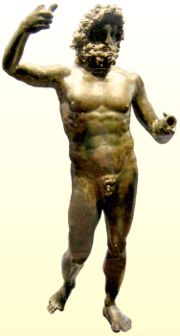Jupiter (mythology)
2007 Schools Wikipedia Selection. Related subjects: Myths
In Roman mythology, Jupiter (Iuppiter in Latin) held the same role as Zeus in the Greek pantheon. He was called Juppiter Optimus Maximus Soter (Jupiter Best, Greatest, Saviour) as the patron deity of the Roman state, in charge of laws and social order. He was the chief god of the Capitoline Triad, with Juno and Minerva.
Jupiter is a vocative compound derived from archaic Latin Iovis and pater (Latin for father), this was also used as the nominative case. Jove is an English formation based on Iov-, the stem of oblique cases of the Latin name. Its Vedic equivalent is Dyaus Pita.
The name of the god was also adopted as the name of the planet Jupiter, and was the original namesake of the weekday that would come to be known in English as Thursday (the etymological root can be seen in various Romance languages, including ( accusative Iovem, genitive Iovis, dative Iovi and ablative Iove - an irregular declension). Linguistic studies identify his name as deriving from the Indo-European compound * dyēus- pəter- ("O Father God"), the Indo-European deity from whom also derive the Germanic *Tiwaz (after whom Tuesday was named), the Greek Zeus, and the French jeudi, Castilian jueves, Italian giovedì and Catalan dijous, all from Latin Iovis Dies, whereas English takes his Norse equivalent, Thor).
Epithets of Jupiter
- Jupiter Caelestis ("heavenly")
- Jupiter Fulgurator ("of the lightning")
- Jupiter Laterius ("God of Latium")
- Jupiter Lucetius ("of the light")
- Jupiter Pluvius ("sender of rain") See also Pluvius
- Jupiter Stator (from stare meaning "standing")
- Jupiter Terminus or Jupiter Terminalus (defends boundaries). (See also Terminus)
- Jupiter Tonans ("thunderer")
- Jupiter Victor (led Roman armies to victory)
- Jupiter Summanus (sender of nocturnal thunder)
- Jupiter Feretrius ("who carries away [the spoils of war]")
- Jupiter Optimus Maximus (best and greatest)
- Jupiter Brixianus (Jupiter equated with the local god of the town of Brescia in Cisalpine Gaul (modern North Italy))
- Jupiter Ladicus (Jupiter equated with a Celtiberian mountain-god and worshipped as the spirit of Mount Ladicus)
- Jupiter Parthinus or Partinus (Jupiter was worshipped under this name on the borders of north-east Dalmatia (Croatia) and Upper Moesia (Bulgaria), perhaps being associated with the local tribe known as the Partheni)
- Jupiter Poeninus (Jupiter was worshipped in the Alps under this name, around the Great St Bernard Pass, where he had a sanctuary)
- Jupiter Solutorius (a local version of Jupiter worshipped around the Castile area in Spain; he was syncretised with the local Iberian god Eacus)
- Jupiter Taranis (Jupiter equated with the Celtic god Taranis)
- Jupiter Uxellinus (Jupiter as worshipped in Austria, as a god of high mountains)
Capitoline Jupiter
The largest temple in Rome was that of Jupiter Optimus Maximus on the Capitoline Hill. Here he was worshipped alongside Juno and Minerva, forming the Capitoline Triad. Jupiter was also worshipped at Capitoline Hill in the form of a stone, known as Iuppiter Lapis or the Jupiter Stone, which was sworn upon as an oath stone. Temples to Juppiter Optimus Maximus or the Capitoline Triad as a whole were commonly built by the Romans at the centre of new cities in their colonies.
The building was begun by Tarquinius Priscus and completed by the last king of Rome, Tarquinius Superbus, although it was inaugurated, by a tradition recorded by the historians, on September 13, at the beginning of the Republican era (509 BC).
The temple building stands on a high podium with an entrance staircase to the front. On three of its sides it was probably surrounded by a colonnade, with another two rows of pillars drawn up in line with those on the façade of the deep pronaos which precedes the three cellae, ranged side by side in the Etruscan manner, the central one being wider than the other two.
The surviving remains of the foundations and of the podium, most of which lie underneath Palazzo Caffarelli, are made up of enormous parallel sections of walling made in blocks of grey tufa-quadriga stone (cappellaccio) and bear witness to the sheer size of the surface area of the temple's base (about 55 x 60 m).
On the roof a terracotta auriga, made by the Etruscan artist Vulca of Veii in the 6th century BC, commissioned by Tarquinius Superbus; it was replaced in 296 B.C., by a bronze one. The cult image, by Vulca, was of terracotta; its face was painted red on festival days ( Ovid, Fasti, 1.201f). Beneath the cella were the favissae, or underground passages, in which were stored the old statues that had fallen from the roof, and various dedicatory gifts.
The temple was rebuilt in marble after fires had worked total destruction in 83 BC, when the cult image was lost, and the Sibylline Books kept in a stone chest. Fires followed in 69 AD, when the Capitol was stormed by the supporters of Vitellius and in 80 AD.
In front of the steps was the altar of Jupiter (ara Iovis). The large square in front of the temple (the Area Capitolina) featured a number of temples dedicated to minor divinities, in addition to other religious buildings, statues and trophies.
Its dilapidation began in the fifth century, when Stilicho carried off the gold -plated doors and Narses removed many of the statues, in 571 AD.
In language
It was once believed that the Roman god Jupiter (Zeus in Greece) was in charge of cosmic Justice, and in ancient Rome, people swore to Jove in their courts of law, which lead to the common expression "By Jove!", still used as an archaism today. In addition, "Jovial" is a medium-common adjective still used to describe people who are jolly, optimistic, and buoyant in temperament.

